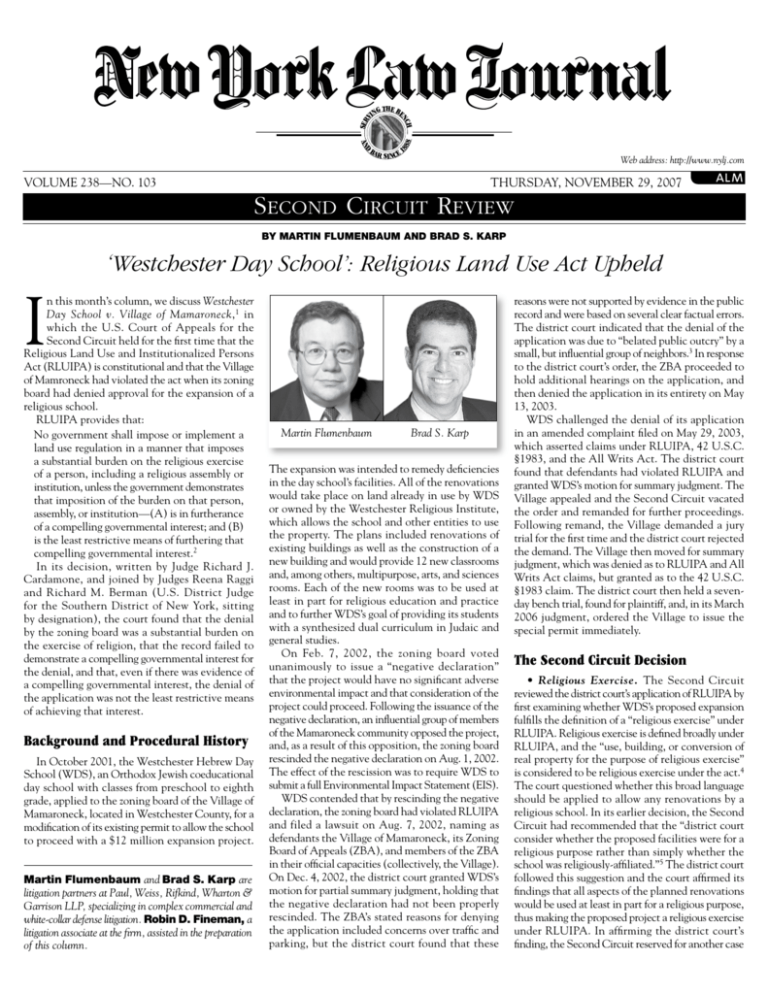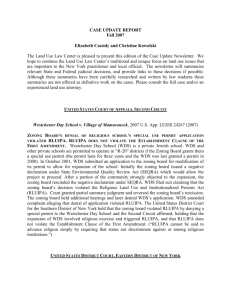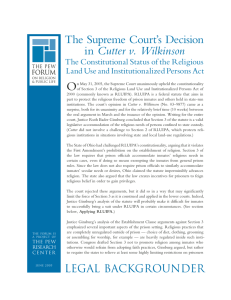
AND
88
8
SER
V
H
NC
THE BE
ING
1
BA
R SINCE
Web address: http://www.nylj.com
Volume 238—no. 103
thursday, november 29, 2007
Second Circuit Review
By Martin Flumenbaum and Brad S. Karp
‘Westchester Day School’: Religious Land Use Act Upheld
I
n this month’s column, we discuss Westchester
Day School v. Village of Mamaroneck, 1 in
which the U.S. Court of Appeals for the
Second Circuit held for the first time that the
Religious Land Use and Institutionalized Persons
Act (RLUIPA) is constitutional and that the Village
of Mamroneck had violated the act when its zoning
board had denied approval for the expansion of a
religious school.
RLUIPA provides that:
No government shall impose or implement a
land use regulation in a manner that imposes
a substantial burden on the religious exercise
of a person, including a religious assembly or
institution, unless the government demonstrates
that imposition of the burden on that person,
assembly, or institution—(A) is in furtherance
of a compelling governmental interest; and (B)
is the least restrictive means of furthering that
compelling governmental interest.2
In its decision, written by Judge Richard J.
Cardamone, and joined by Judges Reena Raggi
and Richard M. Berman (U.S. District Judge
for the Southern District of New York, sitting
by designation), the court found that the denial
by the zoning board was a substantial burden on
the exercise of religion, that the record failed to
demonstrate a compelling governmental interest for
the denial, and that, even if there was evidence of
a compelling governmental interest, the denial of
the application was not the least restrictive means
of achieving that interest.
Background and Procedural History
In October 2001, the Westchester Hebrew Day
School (WDS), an Orthodox Jewish coeducational
day school with classes from preschool to eighth
grade, applied to the zoning board of the Village of
Mamaroneck, located in Westchester County, for a
modification of its existing permit to allow the school
to proceed with a $12 million expansion project.
Martin Flumenbaum and Brad S. Karp are
litigation partners at Paul, Weiss, Rifkind, Wharton &
Garrison LLP, specializing in complex commercial and
white-collar defense litigation. Robin D. Fineman, a
litigation associate at the firm, assisted in the preparation
of this column.
Martin Flumenbaum
Brad S. Karp
The expansion was intended to remedy deficiencies
in the day school’s facilities. All of the renovations
would take place on land already in use by WDS
or owned by the Westchester Religious Institute,
which allows the school and other entities to use
the property. The plans included renovations of
existing buildings as well as the construction of a
new building and would provide 12 new classrooms
and, among others, multipurpose, arts, and sciences
rooms. Each of the new rooms was to be used at
least in part for religious education and practice
and to further WDS’s goal of providing its students
with a synthesized dual curriculum in Judaic and
general studies.
On Feb. 7, 2002, the zoning board voted
unanimously to issue a “negative declaration”
that the project would have no significant adverse
environmental impact and that consideration of the
project could proceed. Following the issuance of the
negative declaration, an influential group of members
of the Mamaroneck community opposed the project,
and, as a result of this opposition, the zoning board
rescinded the negative declaration on Aug. 1, 2002.
The effect of the rescission was to require WDS to
submit a full Environmental Impact Statement (EIS).
WDS contended that by rescinding the negative
declaration, the zoning board had violated RLUIPA
and filed a lawsuit on Aug. 7, 2002, naming as
defendants the Village of Mamaroneck, its Zoning
Board of Appeals (ZBA), and members of the ZBA
in their official capacities (collectively, the Village).
On Dec. 4, 2002, the district court granted WDS’s
motion for partial summary judgment, holding that
the negative declaration had not been properly
rescinded. The ZBA’s stated reasons for denying
the application included concerns over traffic and
parking, but the district court found that these
reasons were not supported by evidence in the public
record and were based on several clear factual errors.
The district court indicated that the denial of the
application was due to “belated public outcry” by a
small, but influential group of neighbors.3 In response
to the district court’s order, the ZBA proceeded to
hold additional hearings on the application, and
then denied the application in its entirety on May
13, 2003.
WDS challenged the denial of its application
in an amended complaint filed on May 29, 2003,
which asserted claims under RLUIPA, 42 U.S.C.
§1983, and the All Writs Act. The district court
found that defendants had violated RLUIPA and
granted WDS’s motion for summary judgment. The
Village appealed and the Second Circuit vacated
the order and remanded for further proceedings.
Following remand, the Village demanded a jury
trial for the first time and the district court rejected
the demand. The Village then moved for summary
judgment, which was denied as to RLUIPA and All
Writs Act claims, but granted as to the 42 U.S.C.
§1983 claim. The district court then held a sevenday bench trial, found for plaintiff, and, in its March
2006 judgment, ordered the Village to issue the
special permit immediately.
The Second Circuit Decision
• Religious Exercise. The Second Circuit
reviewed the district court’s application of RLUIPA by
first examining whether WDS’s proposed expansion
fulfills the definition of a “religious exercise” under
RLUIPA. Religious exercise is defined broadly under
RLUIPA, and the “use, building, or conversion of
real property for the purpose of religious exercise”
is considered to be religious exercise under the act.4
The court questioned whether this broad language
should be applied to allow any renovations by a
religious school. In its earlier decision, the Second
Circuit had recommended that the “district court
consider whether the proposed facilities were for a
religious purpose rather than simply whether the
school was religiously-affiliated.”5 The district court
followed this suggestion and the court affirmed its
findings that all aspects of the planned renovations
would be used at least in part for a religious purpose,
thus making the proposed project a religious exercise
under RLUIPA. In affirming the district court’s
finding, the Second Circuit reserved for another case
thursday, november 29, 2007
New York Law Journal
the question of the nature of a project by a religious
institution that would not fall under RLUIPA.
• Substantial Burden. In addressing whether the
denial of WDS’s building application constituted
a substantial burden under the act, the court, in
agreement with the U.S. Court of Appeals for
the Eleventh Circuit, set forth a “coercion test,”
stating that “when there has been a denial of a
religious institution’s building application, courts
appropriately speak of government action that
directly coerces the religious institution to change
its behavior….”6 Further, there must be a “close
nexus between the coerced or impeded conduct
and the institution’s religious exercise for such
conduct to be a substantial burden on that religious
exercise.”7 The court also acknowledged that if the
denial of the application to build is not absolute
and the religious institution has an opportunity
to modify its application, then it is less likely that
substantial burden will be found.
In discussing the “substantial burden” element of
the act, the court noted the decisions of several of
its sister circuits, which have found that legitimate
neutrally imposed land use restrictions do not pose
a substantial burden when applied to a religious
entity, but where the zoning rules are applied in
an “arbitrary and capricious” manner and are not
related to the public health, safety or welfare, as the
district court found was evident in the record before
it, then the government’s actions can amount to a
substantial burden under RLUIPA. Here, the court
noted as relevant the district court’s conclusion
that the ZBA’s actions violated New York law and
concluded that the record demonstrates that the
denial by the ZBA was the result of an “arbitrary
blindness to the facts.”8
Continuing its substantial burden analysis, the
court returned to two issues it had raised in its prior
opinion in this case: whether the institution had
an alternative to meet its religious needs absent the
construction permit, and whether the denial was
conditional or absolute. Based on the record, the
court concluded that “there were not only no quick,
reliable, or economically feasible alternatives, there
were no alternatives at all.”9 In terms of whether
the denial was absolute, the court listed several
considerations: (a) the zoning board’s classification
of the denial; (b) whether any required modification
would itself pose a burden on religious exercise; (c)
whether an amendment to address problems noted
by the zoning board was economically unworkable;
and (d) whether the zoning board’s willingness to
consider a modified proposal was disingenuous.10
After reviewing the facts in the record for these
factors, the court concluded that WDS had shown
that the denial was absolute and thus the ZBA’s
actions substantially burdened its religious exercise.
• Compelling Governmental Interest. Turning
to the last piece of the analysis under RLUIPA,
the court relied upon the finding of the district
court that the application was not denied because
of a compelling governmental interest. The panel
further concluded that even if the court were to find
a compelling government interest, the Village did
not use the least-restrictive means to achieve that
interest. The ZBA had the opportunity to approve
WDS’s application subject to modifications, which
would have addressed certain public health and
safety concerns; instead, the ZBA was swayed by
the opposition of a small group of members of
the community and rejected the application in
its entirety.11
Constitutionality
The Second Circuit then addressed the
constitutionality of RLUIPA, a question that
it had not previously reached. The Village
challenged RLUIPA as exceeding the authority
granted to Congress under §5 of the Fourteenth
Amendment and under the Commerce Clause,
and as a violation of the Tenth Amendment and
the Establishment Clause. After examining these
arguments, the Second Circuit found that RLUIPA
was constitutionally applied to the ZBA’s denial of
the application and that the land use provisions of
RLUIPA are constitutional.
First, the district court constitutionally applied
the act under the Commerce Clause. The court
noted that RLUIPA is jurisdictionally limited to
cases in which the substantial burden has at least
a “minimal effect” on interstate commerce, and
consistent with Second Circuit precedent, the court
held that where the “relevant jurisdictional element
is satisfied, RLUIPA constitutes a valid exercise
of congressional power under the Commerce
Clause.”12 WDS’s construction of the new building
was sufficient to demonstrate the necessary minimal
effect on commerce. Given the constitutionality of
the application of RLUIPA under the Commerce
Clause, the court declined to reach the question
of whether RLUIPA was constitutionally applied
under §5 of the Fourteenth Amendment.
The court next turned to the Village’s argument
that RLUIPA violates the Tenth Amendment. The
Court held that RLUIPA is permissible under the
Tenth Amendment because it does not directly
compel “states to require or prohibit any particular
acts” and the act allows “each state to enact and
enforce land use regulations as it deems appropriate
so long as the state does not substantially burden
religious exercise in the absence of a compelling
interest achieved by the least restrictive means.”13
The court also rejected the argument that RLUIPA
violates the Establishment Clause. Applying the
three-prong analysis set forth by the Supreme Court
in Lemon v. Kurtzman, 403 U.S. 602 (1971), and its
holding in Cutter v. Wilkinson, 544 U.S. 709, 720
(2005), that RLUIPA’s institutionalized persons
provisions are constitutional, the court concluded
that RLUIPA’s land use restrictions have a secular
purpose permissible under the Establishment Clause;
namely, to “lift government-created burdens on
private religious exercise.”14 The court further held
that the principal effect of the land use provisions
neither advances nor inhibits religion. Rather,
the principal effect of RLUIPA is to permit the
exercise of religious beliefs free of government
burden. For similar reasons, the court concluded
that RLUIPA’s land use provisions do not facilitate
excessive government entanglement with religion.
Jury Trial Waiver
The Village also appealed the district court’s denial
of its demand for a jury trial, arguing that its amended
answer raised new issues and that it had the right to a
jury trial on those issues. The Second Circuit found
that the only new issues were additional affirmative
defenses raised in the amended answer, but that
these defenses were based on the same facts, and thus
defendants were not entitled to the right to demand a
jury trial. According to the court, the district court also
properly exercised its discretion under Federal Rule of
Civil Procedure 39(b) in denying the Village’s request
for a jury trial because the Village admittedly neglected
to demand the jury trial at the proper time.
All Writs Act
Last, the court declined to examine the district
court’s additional justifications, grounded in the
All Writs Act and in supplemental state law
claims, for its order that the ZBA “immediately
and unconditionally” issue the permit to WDS
because, according to the court, this relief was
proper under RLUIPA.
Conclusion
With its decision in Westchester Day School v.
Village of Mamaroneck, the Second Circuit has
determined that the land use provisions of the
controversial RLUIPA are constitutional and has
given religious groups nationwide ammunition in
confrontations with local zoning boards and towns
and municipalities over land use regulation. The
decision does leave open, however, the question of
precisely where the line should be drawn as to the
nature of the land use that will fulfill the definition
of religious exercise and implicate RLUIPA. Also
uncertain is whether a denial by a zoning board that
does not rise to the level of being “arbitrary and
capricious,” but is not necessarily neutrally imposed,
will be deemed a substantial burden. Given that
the application and interpretation of the land use
provisions of RLUIPA remain unsettled, this case
or one from a sister circuit dealing with these issues
will likely be resolved by the Supreme Court.
•••••••••••••
••••••••••••••••
1. No. 06-1464-cv, —F.3d—, 2007 WL 3011061 (2d Cir. Oct.
17, 2007).
2. 42 U.S.C. §2000cc(a)(1).
3. Westchester Day Sch. v. Vill. of Mamaroneck, 236 F.Supp.2d
349, 359 (S.D.N.Y. 2002).
4. 42 U.S.C. §2000cc-5(7)(A)-(B).
5. Westchester Day Sch., 2007 WL 3011061, at *4.
6. Id. at *6.
7. Id.
8. Id. at *8-9.
9. Id. at *9.
10. Id. at *10.
11. Id. at *11.
12. Id. at *12.
13. Id.
14. Id. at *13.
Reprinted with permission from the November 29, 2007 edition of the New York Law Journal © 2007 ALM Properties, Inc.
All rights reserved. Further duplication without permission is
prohibited. For information, contact 212-545-6111 or visit
www.almreprints.com. # 070-11-07-0034












